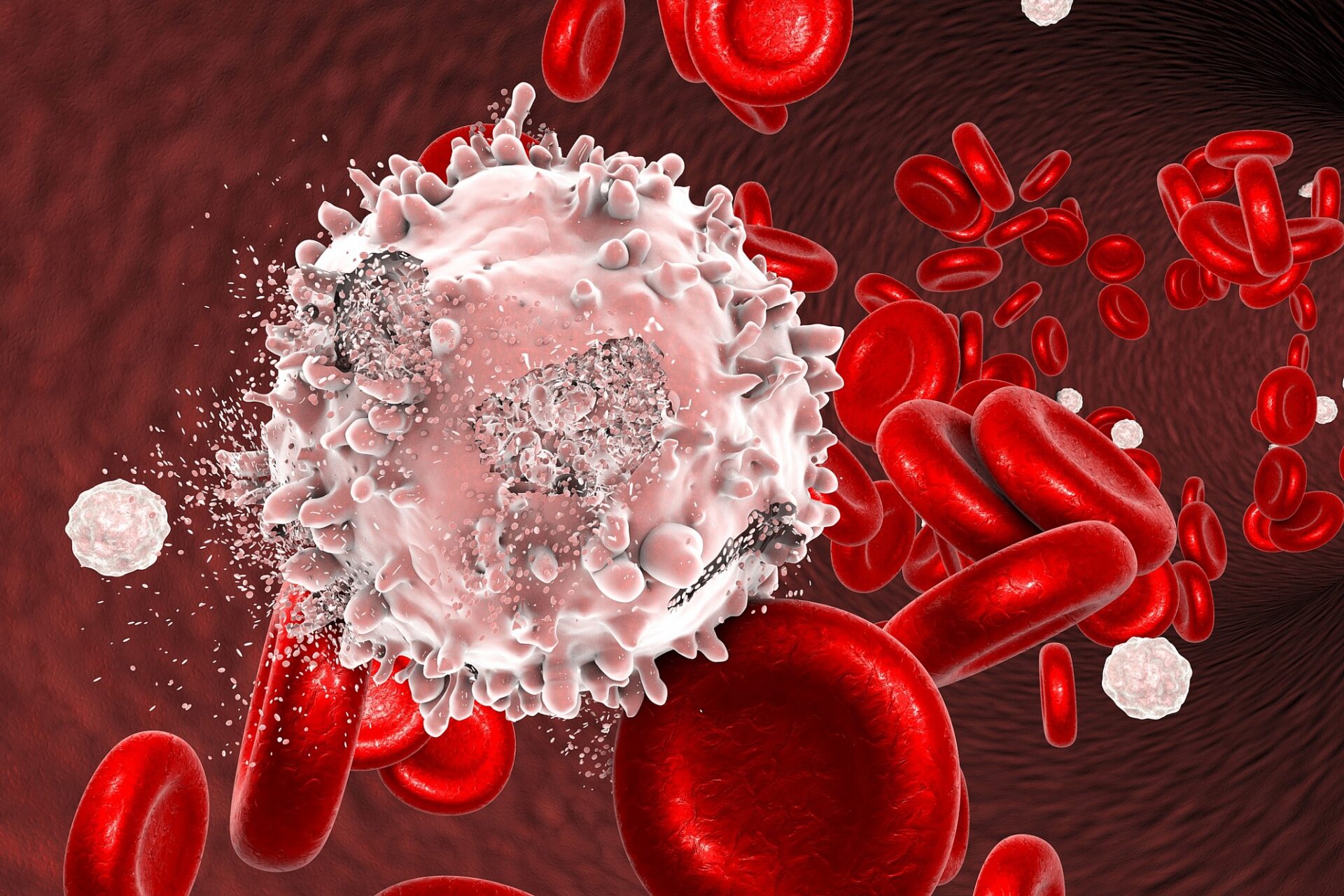Illustrative image of the destruction of a leukemia cell (Dr_Microbe, iStock by Getty Images)
Over the last few decades, recent scientific research and technological advances have enabled a greater understanding of the pathogenesis of leukemia, a disease that affects around 45,000 people in the United States each year.
However, despite improvements in the development of immune and novel targeted therapies, the overall outcome for patients with leukemia remains poor, which makes treating this type of cancer particularly challenging. Against this backdrop, there is an urgent need for further clinical research into new drugs, strategies, and approaches to treat leukemia.
Sofpromed is an oncology-focused CRO that has been helping small and mid-sized biotech companies conduct clinical research studies in leukemia for many years. Our priority is to provide the best management services to all of our partners, thus helping them optimize performance and, by extension, produce the best results possible.
- $What Is Leukemia?
- $Prevalence and Risk Factors of Leukemia in the US
- $Current Medical Treatments for Leukemia and Need for Adult Patients to Conduct Clinical Research
- $What Services Does Sofpromed Provide to Biotech Companies Conducting Clinical Trials for Leukemia?
- $Sofpromed: A Real Partner for Biotech Companies Conducting Clinical Research on Leukemia
What Is Leukemia?
Leukemia is a generic term for cancer of the blood cells. It begins in the blood-forming tissues of the body, such as the bone marrow and the lymphatic system. There are several types of leukemia, each of which requires a different type of treatment.
The bone marrow is the soft, spongy tissue found in the center cavity of most bones. This is the space where new blood cells are produced. There are three existing types of blood cells generated in the bone marrow:
- Red blood cells (erythrocytes): these cells carry oxygen and other materials to all the tissues and organs of the body.
- White blood cells (granulocytes, monocytes, and lymphocytes): they are part of the body’s immune system, and help us fight infections and other illnesses.
- Platelets: they are cell fragments in our blood which form clots and prevent bleeding.
Leukemia occurs when the DNA of the blood cells generated in the bone marrow undergoes a series of changes (mutations), which results in an out-of-control growth and multiplication of cancer cells. These abnormal cells are normally white blood cells.
The rapid growth and replication of blood cells has severe disadvantages. First, cancer cells serve no purpose whatsoever. Second, they crowd out healthy cell types, not leaving enough space for them to develop and work properly. As a result of the lack of other blood cells, the organs will not receive the oxygen needed to function in the normal way, nor will the body be able to fight infection or control bleeding when necessary.
In addition, this increasingly large number of abnormal cells may spill into the bloodstream and invade other tissues and organs —such as the liver, spleen or lymph nodes— causing discomfort and organ dysfunctions. In other words, this phenomenon (known as ‘metastasis’) may trigger serious health problems in the short or long term.
Leukemia is generally classified by the type of blood cell affected and by the speed of disease progression. On the one hand, leukemia can be acute, if cancer cells multiply rapidly, or chronic, if cancer blood cells develop more slowly. While acute leukemia requires aggressive, timely treatment due to its rapid worsening, chronic leukemia may go unnoticed for many years owing to the absence of symptoms that characterizes the initial stages of this disease.
On the other hand, leukemia can also be lymphocytic or myelogenous. Lymphocytic leukemia affects lymphocytes, that is, the cells which form lymphoid tissues. These tissues are part of the immune system and help protect our body against bacteria and other foreign invaders.
By contrast, myelogenous leukemia begins in myeloid cells, which give rise to white blood cells, red blood cells, and platelet-producing cells. Myelogenous leukemia is characterized by an abnormal increase in the number of myelocytes, myeloblasts and granulocytes in the bloodstream.
As mentioned earlier, there are various types of leukemia. The main types of this oncological disease are listed below:
- Acute lymphocytic leukemia (ALL): It starts in the bone marrow and affects more children than adults. In fact, ALL is the most common type of leukemia in infant children.
- Acute myeloid leukemia (AML): This type of leukemia can occur in children and adults, yet it is far more frequent in adults.
- Chronic lymphocytic leukemia (CLL): It arises from lymphocytes, and it is often diagnosed at a late stage of the disease. CLL is the most common chronic leukemia in older adults, accounting for almost one-third of all leukemias.
- Chronic myeloid leukemia (CML): This type of cancer begins in the blood-forming cells of the bone marrow, and represents around 10% of all leukemias. CML usually manifests itself many months or years after the onset of the disease.
These are the types of leukemia affecting more people in the US. Nevertheless, it should be taken into account that there exist other less common types of leukemia —hairy cell leukemia (HCL), large granular lymphocytic (LGL) leukemia, B-cell prolymphocytic leukemia (B-PLL)— and abnormalities that make diagnosis difficult.
Prevalence and Risk Factors of Leukemia in the US
New cases of leukemia are expected to account for 2.3% of the 1.9 million new cancer cases that will be diagnosed in the US in 2022. This means that an estimated 60,650 people will receive a new diagnosis of leukemia this year in that nation: 35,810 males and 24,840 women.
The number of cases and mortality associated with leukemia differ from region to region. According to the American Cancer Society website, the states with the highest incidence of this type of cancer are Minnesota, Wisconsin, Iowa, and South Dakota, while the highest death rates are found in Oklahoma, Kansas, Kentucky, North Dakota, and West Virginia. [1]
The risk factors associated with leukemia are as follows:
- Previous cancer treatment: patients who received chemotherapy or radiation therapy in the past are more likely to develop leukemia.
- Exposure to industrial chemicals: some chemicals found in household products and building materials, such as benzene and formaldehyde, have been shown to cause cancer of the blood.
- Smoking: cigarettes contain cancer-causing substances that may get into the bloodstream and spread to different tissues and organs.
- Rare genetic syndromes and disorders: leukemia has been associated with certain genetic abnormalities, including Down syndrome, Shwachman-Diamond syndrome, ataxia-telangiectasia, or neurofibromatosis, among others.
- Family history of leukemia: the risk of developing leukemia is higher in those people whose relatives have been diagnosed with this disease.
In terms of leukemia prevalence, the rates of new diagnoses vary by age group. Leukemia is more frequently diagnosed in men over the age of 55. In fact, the probability of developing this disease reaches a plateau at around 74 years of age. [2]
Percent of new cases per age group: leukemia.
SOURCE: National Cancer Institute (NIH)
Nevertheless, leukemia is also a fairly common type of cancer in children under the age of 15. Actually, of all the children who will have any type of cancer, around 25% will develop some form of leukemia, and the median age for acute lymphocytic leukemia (ALL), the most common subtype in children, is 14.
National statistics indicate that 5.2 out of 100,000 children aged 0-19 were diagnosed with leukemia in 2016. In contrast, by 2019, the number of new cases of leukemia in children had decreased to 4.2, which suggests the positive impact of medical advances made during the last few years. [3]
Furthermore, unlike other types of cancer, leukemia is more common in Caucasian individuals than in African Americans. In spite of this, a comprehensive study conducted in 2018 shows that Black people have the worst 5-year survival from most existing leukemia subtypes, including ALL, AML, and CLL. As an illustration, “for ALL, the mean survival for Whites and Blacks are 94.3 and 82.8 months, respectively”. [4]
Current Medical Treatments for Leukemia and Need for Adult Patients to Conduct Clinical Research
Overall, the sooner a disease is diagnosed, the greater the possibility of successful treatment. Nonetheless, early detection of leukemia does not always translate into better prognosis.
For example, although the signs of acute leukemia generally start soon after the onset of the disease, it is more aggressive and develops much more quickly than chronic leukemia. Therefore, while chronic leukemia may go unnoticed or undiagnosed for a long period of time, since the disease progresses slowly, acute leukemia will require immediate treatment.
However, it does not mean that chronic leukemia is less severe than acute leukemia. The seriousness of blood cancer will largely depend on the location and type of leukemia, as well as the general health of the patient.
As already stated, early detection of leukemia is usually difficult as its signs and symptoms are often mild, vague and almost unnoticeable. Indeed, leukemia is often found during a routine blood test, before symptoms appear.
In addition, the symptoms of leukemia may also be easily mistaken for those associated with other diseases, such as the flu or other viruses. Therefore, it is common that people with leukemia overlook the abnormalities experienced until their condition becomes more critical. Typical symptoms of leukemia include:
- Anemia (due to the lack of red blood cells to carry oxygen to the body’s tissues)
- Easy bruising and bleeding (resulting from the low levels of platelets)
- Frequent or severe infections (caused by the low levels of white blood cells)
- Fever and night sweats
- Loss of appetite or unintentional weight loss
- Bone or joint pain or tenderness
- Recurrent nosebleeds and bleeding gums
- Tiny red spots on the skin (petechiae)
- Swollen lymph nodes, enlarged spleen or liver
- Weakness and persistent fatigue
- Respiratory difficulties
Experiencing the abovementioned symptoms does not necessarily mean that a person has leukemia. This notwithstanding, it is essential to learn how to recognize these symptoms and make an appointment with a doctor if they persist or worsen.
Scheduling a consultation with a doctor will help the patient clearly understand his/her actual health situation. First of all, the physician will conduct a series of tests (e.g. physical exam, blood tests, bone marrow biopsy) to determine the specific type of disease.
Once the results have been obtained, this professional will give the patient a detailed explanation of the disease, the treatment options available, the benefits and risks of each type of treatment, and their potential long-term side effects. In short, a medical consultation will ensure proper diagnosis and treatment.
Moreover, it may be useful to seek a second opinion, which consists of choosing to consult another knowledgeable professional other than your doctor to hear a different perspective. This specialist will review your full medical history and the treatment plan chosen for your medical condition, and will confirm (or disconfirm) the advice offered by the previous doctor.
Treatment approaches will depend on the type of leukemia, the stage of the disease, the age and overall health of the patient, response to initial treatment, and other factors. The most common treatment plans for leukemia are described below.
Chemotherapy
Chemotherapy is the primary treatment option for many types of leukemia. It uses cytotoxic drugs to kill cancer cells, or stop their growth and/or replication. Treatment consists of cycles, that is, the patient will have to take some rest days after receiving each chemotherapy treatment session to allow the body to recover.
Anticancer drugs may be taken in pill form or administered directly into a vein. Moreover, these anticancer medicines may be given alone or in combination with other chemicals. However, it is important to take into account that a combination of drugs may result in cells being more vulnerable to treatment.
Radiation therapy
This type of treatment uses high-energy X-rays, or similar forms of radiation, to harm leukemia cells, and prevent them from dividing and spreading to other organs or tissues. It is usually the best treatment choice when leukemia has spread to the central nervous system (CNS).
Radiotherapy can be directed to specific sites in the body, where there is a collection of cancer cells, or given over the whole body. Radiation therapy is often used to prepare the body for a bone marrow transplant.
Immunotherapy
Immunotherapy (also referred to as biologic therapy) is a type of modern treatment that works by training the immune system to destroy cancer cells. In other words, it is the patient’s own body that will fight leukemia. Examples of immunotherapies include interferon and CAR T-cell therapy.
The immune system is mainly made up of organs, white blood cells and proteins (antibodies). It has a vital role: to protect the body against potentially harmful foreign agents, including viruses, bacteria, allergens, among others. Nevertheless, it can also be programmed to identify and attack leukemia cells. Immunotherapy causes less side effects than traditional forms of treatment as this type of therapy does not damage healthy cells.
Targeted therapy
Targeted therapy uses drugs to focus on specific features present within leukemia cells. The function of this type of treatment is to block the action of various proteins, enzymes and other molecules which play a role in allowing leukemia cells to divide and multiply. It does this by cutting off the blood supply required for the cells to live. As a result, cancer cells die.
Novel targeted therapy is less likely to damage healthy cells than other forms of treatment. However, before the start of treatment, leukemia cells have to be tested in order to decide whether or not to apply this type of therapy, which will depend on the patient’s particular situation. Targeted therapies may include the following drugs or substances: ofatumumab, gemtuzumab, tyrosine kinase inhibitors, imatinib, among many others.
Stem cell transplantation
Stem cell transplantation (aka hematopoietic cell transplant or bone marrow transplant) is a treatment used when the bone marrow has been destroyed by cancer, chemo or radiation therapy. The aim of this procedure is to replace the remaining cancerous blood-forming cells destroyed by previous medical action with new, healthy blood-forming stem cells.
These leukemia-free stem cells can be taken from the patient himself or herself, prior to the start of other therapies, or from a donor’s blood or bone marrow, which will be infused back into the patient’s blood. In the latter case, the new immune system kills cancer cells because it recognizes them as foreign. To sum up, stem cell transplantation will help regenerate healthy bone marrow.
Clinical Trials
In some cases, taking part in a carefully conducted clinical trial may be the best treatment plan for patients with leukemia. Clinical trials have certainly led to major clinical improvements in wellbeing and survival of patients with acute leukemia, a type of cancer whose treatment may be particularly challenging due to its many genetic abnormalities.
Clinical trials test new drugs and therapies that may become the next standard treatments for leukemia in the near future. Clinical research studies are designed to be very safe, accurate, and compliant with both Good Clinical Practice (GCP) rules and current legislation governing the use of medicines and medical devices. Not only are investigators committed to attain high standards of quality but, more importantly, they give the highest priority to the best possible level of safety for patients.
At present, a considerable number of drugs and treatments for leukemia are under study. Investigators are constantly pursuing new methods and approaches aimed at increasing the rate of remission as well as finding a cure for AML and ALL, the two types of leukemia affecting more adults and children in the world.
New approaches seek to achieve a greater understanding of the genetic variations characterizing the disease in order to develop new strategies and customize treatment options. Some of their objectives include killing leukemia cells more straightforwardly, inhibiting the production of substances involved in their growth or replication, or boosting the immune response against cancer cells.
Regardless of their treatment stage or condition, all people with leukemia can take part in a clinical trial. Actually, there are clinical studies for newly diagnosed patients, relapsed patients, patients with advanced disease, and transplant patients. Moreover, patients who join clinical trials are classified in different groups according to their ability to resist or tolerate medications. All these measures are essential to ensure that the specific needs of every patient are met.
What Services Does Sofpromed Provide to Biotech Companies Conducting Clinical Trials for Leukemia?
Clinical trials are essential for discovering new treatments for diseases as well as evaluating the efficacy and safety of drugs and therapies currently given to patients. In recent years, and even more so after the outbreak of the global health crisis that began in 2019, there has been an increased awareness of the importance of scientific research to achieve greater well-being and safety for the world’s population. More than ever, health has become a central priority in our lives.
As a result, the last few years have witnessed a global boom in the pharmaceutical industry, which has grown steadily. In parallel with the investment pipeline and the everfiercer competition in the medical field, the requirements of the competent regulatory authorities —among which the US Food and Drug Administration (FDA) is included— have become more stringent, and this tendency is expected to continue.
Certainly, the increasing competitiveness of the market and the constantly changing regulatory environment have led to the emergence of new challenges for biotech and pharma companies. In this context, they need the support of a partner that can accelerate and optimize all the processes related to clinical research.
As a small-sized CRO specialized in oncology, Sofpromed provides clinical trial sponsors with the management services and tools needed to conduct oncology studies in an efficient, orderly, quick, and compliant way. Our CRO’s main goal is to improve the quality of clinical research and ensure that outcomes are based on best practice. In this section, we will focus on the advantages and benefits of working in collaboration with Sofpromed.
Expert knowledge of leukemia
In order to ensure clinical trial success, all the personnel involved in clinical research should have profound knowledge of the disease. Due to their extensive training and experience in the sector, the staff provided by our CRO (e.g. clinical research associates, project managers, data managers) stand out for their in-depth knowledge of oncological diseases such as leukemia. Certainly, it is an added value without which it would be impossible to obtain satisfactory results.
Contact with oncology key opinion leaders (KOLs)
The quality of a cancer clinical trial can be enhanced with the input of highly regarded oncology specialists. These experts in the world of medicine, known as key opinion leaders (KOLs), are on the front lines of patient care. This gives them unique insights into diagnosis and procedure trends. Not only that, but they may also know which treatments are most effective for each group of patients. Hence, they can offer valuable advice and help boost the development of successful new drugs.
Due to our experience managing clinical studies in oncology, we have close contact with senior doctors specialized in cancer. We can provide you with these expert physicians, who will undoubtedly add scientific value to your study.
Established connections with cancer clinical site networks in the US
As a truly global company, Sofpromed also has direct contact with the most prestigious cancer centers in the United States. Our CRO can select the best hospitals recruiting patients with leukemia, thus saving you valuable time and effort. This is particularly practical if you plan to recruit patients with rare cancers for your clinical trial.
Client proximity
Ultimately, our CRO has been considered a very close partner. We place great importance on communication and understanding our customer’s needs with the aim of providing them with the best possible service. This great responsiveness makes us the perfect partner for small and mid-sized biotech companies developing new drugs and treatments for leukemia patients in the US.
Below is a summary list of the services offered by our CRO:
- Clinical operations: our clinical research associates (CRAs) and clinical project managers (CPMs) have valuable technical knowledge and skills. Their tasks include site selection and activation, onsite monitoring visits, clinical site management, global study supervision, and many others.
- Biometrics: our team of professional data managers and statistical programmers leverage their strong data managing capacities to ensure the accuracy of all data collected during a clinical trial.
- Web tools: we offer web-based tools aimed at optimizing the tasks related to clinical investigation. These tools include the EDC system, the electronic Trial Master File (eTMF), and the DICOM imaging platform for radiological reviews.
Sofpromed: A Real Partner for Biotech Companies Conducting Clinical Research on Leukemia
Sofpromed is a clinical research organization (CRO) specialized in managing phase I-IV clinical trials in oncology, in general, and in leukemia, in particular. Our CRO stands out for its vast knowledge of the disease, great commitment and expertise. For more than a decade, Sofpromed has been offering a wide variety of services, ranging from clinical operations to biometrics and clinical software development. Our work philosophy is to speed up all the trial management activities that are part of the research life-cycle, from study initiation to study closure, while ensuring as much safety, quality and scientific accuracy as possible.
All these managing tasks are performed by highly skilled specialists with great vocation and extensive experience in the health sector. Ultimately, we always strive to forge long-lasting and mutually beneficial relationships with the companies that decide to trust our competent professional teams. These are the reasons that make Sofpromed the perfect match for small and mid-sized biotech companies planning to conduct leukemia clinical trials across the US and Europe.
Please contact us at info@sofpromed.com if you need a CRO to conduct a leukemia clinical trial in the US
References:
[1] American Cancer Society. “Leukemia: Types of Leukemia.” [Accessed 10 May 2022].
[2] National Cancer Institute (NIH): “Cancer Stat Facts: Leukemia.” [Accessed 13 May 2022]










